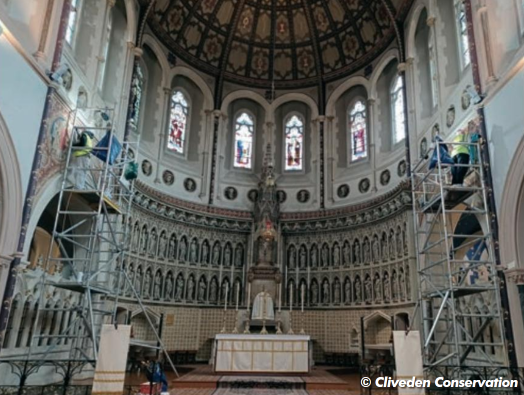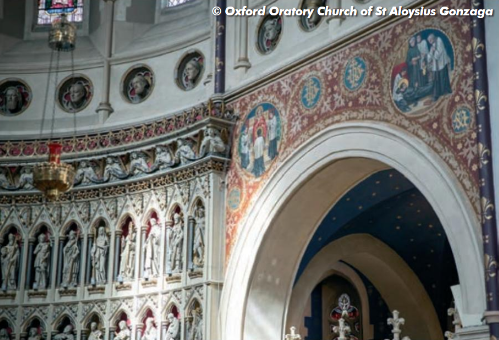Painstaking effort reveals vibrancy of murals
 Conservation of both sides of the sanctuaryDuring the 1950s the sanctuary of the Grade Two-listed Oratory Church of St Aloysius Gonzaga was reconfigured, the high altar was simplified and moved forward and all the polychrome decoration was over-painted. To restore its lost beauty, two large murals by Gabriel Pippet have now been uncovered. Polly Westlake, conservator at Cliveden Conservation, explains more about the project.
Conservation of both sides of the sanctuaryDuring the 1950s the sanctuary of the Grade Two-listed Oratory Church of St Aloysius Gonzaga was reconfigured, the high altar was simplified and moved forward and all the polychrome decoration was over-painted. To restore its lost beauty, two large murals by Gabriel Pippet have now been uncovered. Polly Westlake, conservator at Cliveden Conservation, explains more about the project.
The Grade Two-listed Oratory Church of St Aloysius Gonzaga was built in 1875 by architect Joseph Hansom and uses beauty to raise hearts and minds to God, faithful to the traditions of St Philip Neri and St John Henry Newman. The Fathers of the Oratory plan to return this beauty to the public by restoring the original plan of the sanctuary ahead of the church’s 150th celebrations in 2025. That will include installing a beautiful new high altar, restoring the nave and extending the church.
The first phase of works – St Aloysius Revealed – began back in 2022 and has been an exciting journey. The church had been under the impression that the murals were in poor condition and that redecorating with a new scheme may be the best option. However, the trials carried out by Cliveden Conservation with Owlsworth IJP revealed the original scheme beneath the modern paint to be in good condition. Within just a short space of time small panels of colour, details of stencilling and gilding could be clearly seen.
 The walls after treatmentAt the start of 2024 Cliveden Conservation was invited back by the Fathers of the Oratory to uncover both of the murals. To limit the disruption to the church services, two tower scaffolds were erected at the sides of the sanctuary to enable conservators to work on the murals simultaneously.
The walls after treatmentAt the start of 2024 Cliveden Conservation was invited back by the Fathers of the Oratory to uncover both of the murals. To limit the disruption to the church services, two tower scaffolds were erected at the sides of the sanctuary to enable conservators to work on the murals simultaneously.
Arbocel (paper pulp) was used to hold de-ionised water against the surface to soften the modern paint so it could be carefully peeled away without damaging the underlaying paint layers. It was incredible to not only see the murals surface but also to find them in very good condition.
There was an area of loss on the north wall to the non-figurative decoration, which needed repairing and recreating. To achieve this, conservators traced existing motifs and transferred them to the repaired plaster surface using acrylic paints. There was also a damaged figurative scene on the south wall which was painstakingly reinstated.
Restoring the lost murals of Gabriel Pippet that depict the life of St Aloysius Gonzaga, the patron of the Oxford Oratory, is a remarkable achievement and an important milestone in returning the beauty back to the sanctuary of the church. It has unlocked details of vibrant colours, gold leaf and exquisite patterns used by Pippet throughout the sanctuary, which is not only key to the whole restoration but also representative of some of the finest decoration of the Catholic Arts and Crafts movement.
With the faces of the saints once again looking out from the murals onto the sanctuary, the church can communicate a strong sense of tradition to everyone who visits and create an inspiring and beautiful place of prayer. The church can also demonstrate the potential and viability of the wider restoration project, attracting valuable attention, funding and support from the community.
For more information visit www.clivedenconservation.com















